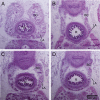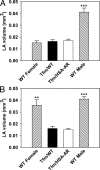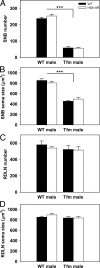Sexual differentiation of the spinal nucleus of the bulbocavernosus is not mediated solely by androgen receptors in muscle fibers
- PMID: 19282382
- PMCID: PMC2703528
- DOI: 10.1210/en.2008-1478
Sexual differentiation of the spinal nucleus of the bulbocavernosus is not mediated solely by androgen receptors in muscle fibers
Abstract
The spinal nucleus of the bulbocavernosus (SNB) neuromuscular system is a highly conserved and well-studied model of sexual differentiation of the vertebrate nervous system. Sexual differentiation of the SNB is currently thought to be mediated by the direct action of perinatal testosterone on androgen receptors (ARs) in the bulbocavernosus/levator ani muscles, with concomitant motoneuron rescue. This model has been proposed based on surgical and pharmacological manipulations of developing rats as well as from evidence that male rats with the testicular feminization mutation (Tfm), which is a loss of function AR mutation, have a feminine SNB phenotype. We examined whether genetically replacing AR in muscle fibers is sufficient to rescue the SNB phenotype of Tfm rats. Transgenic rats in which wild-type (WT) human AR is driven by a human skeletal actin promoter (HSA-AR) were crossed with Tfm rats. Resulting male HSA-AR/Tfm rats express WT AR exclusively in muscle and nonfunctional Tfm AR in other tissues. We then examined motoneuron and muscle morphology of the SNB neuromuscular system of WT and Tfm rats with and without the HSA-AR transgene. We observed feminine levator ani muscle size and SNB motoneuron number and size in Tfm males with or without the HSA-AR transgene. These results indicate that AR expression in skeletal muscle fibers is not sufficient to rescue the male phenotype of the SNB neuromuscular system and further suggest that AR in other cell types plays a critical role in sexual differentiation of this system.
Figures






Comment in
-
Sexual differentiation of the nervous system: where the action is.Endocrinology. 2009 Jul;150(7):2991-3. doi: 10.1210/en.2009-0388. Endocrinology. 2009. PMID: 19549884 Free PMC article. No abstract available.
Similar articles
-
Characterization of the spinal nucleus of the bulbocavernosus neuromuscular system in male mice lacking androgen receptor in the nervous system.Endocrinology. 2012 Jul;153(7):3376-85. doi: 10.1210/en.2012-1001. Epub 2012 May 14. Endocrinology. 2012. PMID: 22585832
-
Androgen spares androgen-insensitive motoneurons from apoptosis in the spinal nucleus of the bulbocavernosus in rats.Horm Behav. 1996 Dec;30(4):424-33. doi: 10.1006/hbeh.1996.0047. Horm Behav. 1996. PMID: 9047268
-
Ontogeny of androgen receptor expression in spinal nucleus of the bulbocavernosus motoneurons and their target muscles in male mice.Neurosci Lett. 2012 Apr 4;513(2):119-23. doi: 10.1016/j.neulet.2012.01.067. Epub 2012 Feb 5. Neurosci Lett. 2012. PMID: 22330750
-
The spinal nucleus of the bulbocavernosus: firsts in androgen-dependent neural sex differences.Horm Behav. 2008 May;53(5):596-612. doi: 10.1016/j.yhbeh.2007.11.008. Epub 2007 Nov 28. Horm Behav. 2008. PMID: 18191128 Free PMC article. Review.
-
Steroid hormone masculinization of neural structure in rats: a tale of two nuclei.Physiol Behav. 2004 Nov 15;83(2):271-7. doi: 10.1016/j.physbeh.2004.08.016. Physiol Behav. 2004. PMID: 15488544 Review.
Cited by
-
Neonatal androgen-dependent sex differences in lumbar spinal cord dopamine concentrations and the number of A11 diencephalospinal dopamine neurons.J Comp Neurol. 2010 Jul 1;518(13):2423-36. doi: 10.1002/cne.22340. J Comp Neurol. 2010. PMID: 20503420 Free PMC article.
-
Sexual differentiation of the nervous system: where the action is.Endocrinology. 2009 Jul;150(7):2991-3. doi: 10.1210/en.2009-0388. Endocrinology. 2009. PMID: 19549884 Free PMC article. No abstract available.
-
Overexpression of androgen receptors in target musculature confers androgen sensitivity to motoneuron dendrites.Endocrinology. 2011 Feb;152(2):639-50. doi: 10.1210/en.2010-1197. Epub 2010 Dec 8. Endocrinology. 2011. PMID: 21147875 Free PMC article.
-
The emerging role of skeletal muscle oxidative metabolism as a biological target and cellular regulator of cancer-induced muscle wasting.Semin Cell Dev Biol. 2016 Jun;54:53-67. doi: 10.1016/j.semcdb.2015.11.005. Epub 2015 Dec 1. Semin Cell Dev Biol. 2016. PMID: 26593326 Free PMC article. Review.
-
Effects of sex steroids on bones and muscles: Similarities, parallels, and putative interactions in health and disease.Bone. 2015 Nov;80:67-78. doi: 10.1016/j.bone.2015.04.015. Bone. 2015. PMID: 26453497 Free PMC article. Review.
References
-
- Holmes GM, Sachs BD 1994 Physiology and mechanics of rat levator ani muscle—evidence for a sexual function. Physiol Behav 55:255–266 - PubMed
-
- Nordeen EJ, Nordeen KW, Sengelaub DR, Arnold AP 1985 Androgens prevent normally occurring cell death in a sexually dimorphic spinal nucleus. Science 229:671–673 - PubMed
Publication types
MeSH terms
Substances
Grants and funding
LinkOut - more resources
Full Text Sources
Other Literature Sources
Research Materials

